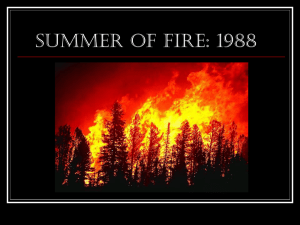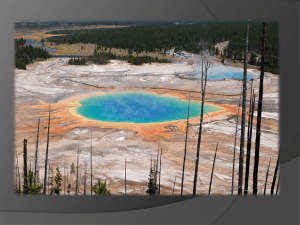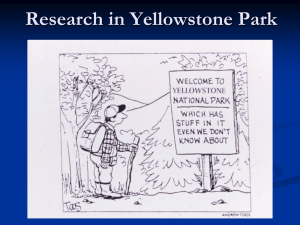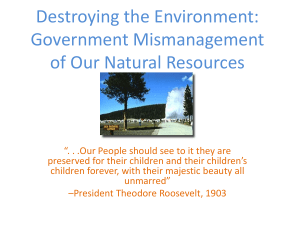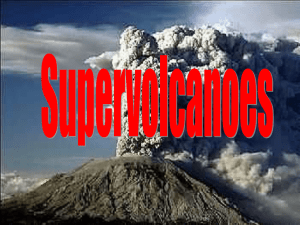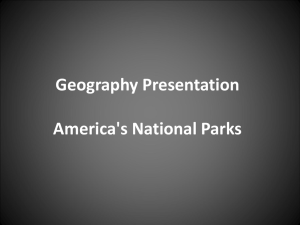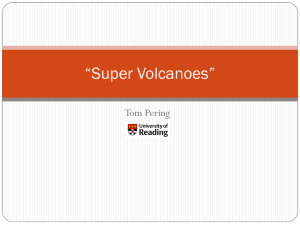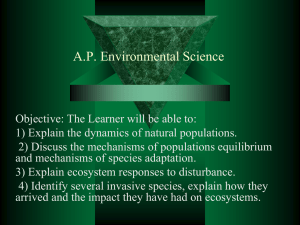Word version
advertisement
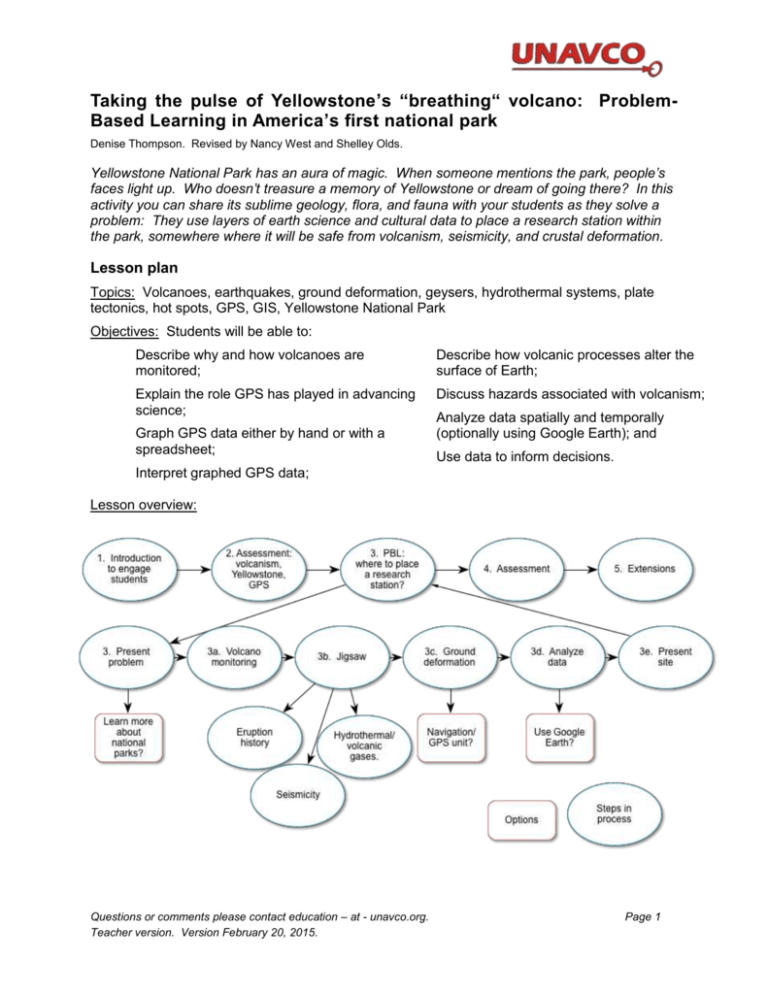
Taking the pulse of Yellowstone’s “breathing“ volcano: ProblemBased Learning in America’s first national park Denise Thompson. Revised by Nancy West and Shelley Olds. Yellowstone National Park has an aura of magic. When someone mentions the park, people’s faces light up. Who doesn’t treasure a memory of Yellowstone or dream of going there? In this activity you can share its sublime geology, flora, and fauna with your students as they solve a problem: They use layers of earth science and cultural data to place a research station within the park, somewhere where it will be safe from volcanism, seismicity, and crustal deformation. Lesson plan Topics: Volcanoes, earthquakes, ground deformation, geysers, hydrothermal systems, plate tectonics, hot spots, GPS, GIS, Yellowstone National Park Objectives: Students will be able to: Describe why and how volcanoes are monitored; Describe how volcanic processes alter the surface of Earth; Explain the role GPS has played in advancing science; Discuss hazards associated with volcanism; Graph GPS data either by hand or with a spreadsheet; Analyze data spatially and temporally (optionally using Google Earth); and Use data to inform decisions. Interpret graphed GPS data; Lesson overview: Questions or comments please contact education – at - unavco.org. Teacher version. Version February 20, 2015. Page 1 Taking the pulse of Yellowstone’s “breathing” volcano Next Generation Science Standards: Performance Expectations: MS-ESS2-2: Construct an explanation based on evidence for how geoscience processes have changed Earth’s surface at varying time and spatial scales. MS-ESS3-2: Analyze and interpret data on natural hazards to forecast future catastrophic events and inform the development of technologies to mitigate their effects. HS-ESS2-4. Use a model to describe how variations in the flow of energy into and out of Earth’s systems result in changes in climate. HS-ESS3-1: Construct an explanation based on evidence for how the availability of natural resources, occurrence of natural hazards, and changes in climate have influenced human activity. HS-ETS1-3. Evaluate a solution to a complex real-world problem based on prioritized criteria and trade-offs that account for a range of constraints, including cost, safety, reliability, and aesthetics, as well as possible social, cultural, and environmental impacts. See Appendix A for related Science and Engineering Practices, Crosscutting Concepts, and Disciplinary Core Ideas from A Framework for K-12 Science Education. Also, Appendix A includes connections to Earth Science Literacy Principles. Summary: In this activity, students learn about volcanism in Yellowstone National Park, focusing on its history of eruption; current seismicity, hydrothermal events, and ground deformation. They learn how scientists monitor volcanoes (using Mount St. Helens as an example) and then apply that to Yellowstone as an open-ended problem. Their task is to identify a site for a research station. Grade Levels: 6 – 12 Teaching Time: At least three class sessions (55 minutes) – and as many as two to three weeks. Organization: This activity consists of three principal parts: 1. Introductory pieces (engaging your students and finding out what they already know); 2. A Problem-Based Learning section in which students learn about volcanism in Yellowstone and select a site for a research station; 3. Concluding pieces in which you assess your students and have the opportunity to extend their learning. Procedure: The general sequence is laid out in the figure on the first page. Numbers correspond to the following steps. (Note that clicking on the following steps takes you to expanded sections with details. 1. Engage your students—Use suggested resources and activities to draw your students into the marvels of Yellowstone and these lessons using videos, images, or an activity that uses an iPhone or iPad as a seismometer. 2. Find out what they already know about monitoring volcanoes, earthquakes, hot spots, Yellowstone National Park, national parks in general, and GPS. This will help you tailor instruction and will let students see how much they learn. 3. Present the problem—Hand out the Student Instructions, which guide students through this set of lessons. Divide students into teams of three. They will work in groups to find a Questions or comments please contact education – at - unavco.org. Teacher version. Version of February 20, 2015. Page 2 Taking the pulse of Yellowstone’s “breathing” volcano location for a permanent research station that will be somewhere they deem to be safe and sensible. Set them to work on the problem. a. Learning to monitor volcanoes—Have them view a presentation about how scientists monitored Mount St. Helens before its 1980 catastrophic eruption—and saved lives by raising the alarm about an impending eruption. You can do this in class as a lecture, individually, or in teams of students. If you “flip” your instruction, this could be a homework assignment. b. Jigsaw activity—Have the students work through presentations to understand and analyze data regarding the area’s history of eruptions, seismicity, and hydrothermal events. Students each become an expert in one of the three topics. For this and the next step on ground deformation, you can ask students to work on paper maps or to use Google Earth. c. Team learning about ground deformation—Have all students, in their teams, learn about how parts of Yellowstone’s topography is changing on a measureable scale. d. Selecting a site for a research station—Have student teams apply what they have learned in the jigsaw activity and about ground deformation and agree upon a place for a research station. This can be done with paper maps or Google Earth. Their instructions also call for them to develop guidelines for determining when the station must be evacuated. e. Presenting and supporting their decision—Students will develop a product of your choice that expresses and explains where they propose placing a research station and why. They might need to persuade others that their site is the best site. 4. Assess—You and your students evaluate what they have learned in this activity. 5. Extend—If you have the time and interest, expand upon this lesson. Materials: Student Instructions--one copy per student or per group Computers for each student group or a computer and projector Presentations and/or printouts of notes. Optimally, students would view the slides as a slideshow and read the notes on paper. Presentations are: Monitoring Yellowstone’s Volcanic Activity Taking the Pulse of Yellowstone’s “Breathing” Caldera—Eruptive History Taking the Pulse of Yellowstone’s “Breathing” Caldera—Seismicity Taking the Pulse of Yellowstone’s “Breathing” Caldera—Hydrothermal Taking the Pulse of Yellowstone’s “Breathing” Caldera—Ground Deformation Yellowstone GPS data sets (Excel file or print copies): 1. “Deformation-four-site-subset”, linked to the presentation Taking the Pulse…Ground Deformation 2. “Deformation-data-2011,” if your students do the second part of the activity in Taking the Pulse…Ground Deformation Graph paper (unless students graph with Excel) Real-time data (Access to Internet or print copies) Colored pencils or transparency pens and transparency sheets—at least four colors per group Google Earth instructions (if needed) Flour, a balloon, tubing, and a box (optional) Introduction Questions or comments please contact education – at - unavco.org. Teacher version. Version of February 20, 2015. Page 3 Taking the pulse of Yellowstone’s “breathing” volcano Yellowstone pulses. A geophysicist, Bob Smith, described it as a “living, breathing caldera”, in interviews in the late 1970s1. This lesson, set amongst the geological and biological marvels of Yellowstone National Park offers you a way to teach your students about volcanism, geysers and other hydrothermal features, seismicity, plate tectonic hot spots, geological monitoring, and how the work of scientists informs decisions made by non-scientists. You will give your students a broad problem to work on in small groups and guide them as they make a decision and present it. This example of Problem-Based-Learning (PBL) could be simple and sweet—three classes—or more comprehensive and open-ended—a full-fledged unit over a week or two. A longer version would fit well just Figure 1. Great Springs of the Firehole River. Thomas Moran, 1871. before a vacation, when students need to be fully engaged with something that intrigues them. We do think though that some pieces are critical for its success; even those have options to meet different time constraints and different students’ needs. In the diagram on the page one, the essential pieces are shown by rectangles. And within those, you can expand or contract the activities. Delicious add-on features are shown as diamonds. In this PBL, the problem (next section) takes advantage of real-time and recent data collected to monitor geological changes and events in this first national park in the world. Yellowstone is a national and international treasure that is sure to engage your students; it is exotic and wild, where the ground smokes and water shoots into the sky while majestic, primeval bison graze and wolves stalk those bison and elk. In this Hadean place, scientists use high-end, elegant and sophisticated technology to measure natural features (e.g. temperature of hot springs) and events (e.g. earthquakes) and to analyze data for changes and trends. Figure 2. Hot Springs on Gardner River. William Henry Jackson, 1871. Your students will gain access to the data, some of which is real-time, via the Internet. They will analyze it through time and across space. They will generate graphs of changes through time. They will use Google Earth or paper maps to compare locations of geological features such as earthquake epicenters and hot springs. Using their analyses, they will recommend a location for a research facility as well as guidelines for deciding when danger necessitates evacuation. Finally, they will present their recommendation verbally, in a brochure, or in a white paper. 1 Achenbach, J. August 2009. “When Yellowstone Explodes.” National Geographic. http://ngm.nationalgeographic.com/2009/08/yellowstone/achenbach-text/1 Retrieved 20 March 2012. Questions or comments please contact education – at - unavco.org. Teacher version. Version of February 20, 2015. Page 4 Taking the pulse of Yellowstone’s “breathing” volcano In Appendix B, we supply general articles or websites for you to read if you want to bolster your own background on Yellowstone. Other resources are listed on the presentations your students will view. The latter are either appropriate for students or they have been used as sources for the presentations. The problem your students will tackle In brief, your students have been hired to find a safe site for a research station in Yellowstone National Park, safe enough to avoid geological hazards for at least 100 years. Researchers must have access by road, yet the station cannot blight the landscape. Students can assume that the site will occupy five to ten acres. A corollary task, to help them focus on changes in the park through time, is to develop a safety protocol that spells out circumstances that would require scientists to evacuate their camp. This scenario is fleshed out on the students’ instructions. 1. Engaging your students Yellowstone is marvelous, and you can use the marvels and their influence on American history and culture to engage your students so that they are eager to work on this problem. The park is the scene of repeated catastrophes, and death and destruction is always a powerful angle. The park represents the classic American family road trip. Visitors can see the greatest concentration of geysers, hot springs, bubbling mud pots in the world. They can see bison, wolves, bears, elk, moose, coyotes, and other animals. Ken Burns, in his series, “National Parks”, caught the nations’ attention in 2010 by highlighting its role as the world’s first national park. (It is also a UNESCO Biosphere Reserve and a World Heritage site, bringing in international visitors.) Artists and art lovers know it through Thomas Moran and Alfred Bierstadt paintings. History buffs love it because of its ties to exploration of the West during the Hayden Survey of 1871. Paintings and photos from that survey influenced Congress to create the National Park System. People who love architecture enjoy the buildings at Figure 3. Castle Geyser, Upper Geyser Basin. Thomas Moran, undated. old Fort Yellowstone and the Old Faithful Lodge. And even people who have none of those interests but who have seen Yogi Bear cartoons are tuned in to Jellystone National Park. We suggest that you use one or more of those connections to intrigue your students in the park, its features, and thus the problem. You could show your students some of the resources listed below or do an activity with your students. Resources are arranged in an Excel spreadsheet to sort2 by content, media, duration, and so on. You can use them to engage your students at the 2 Highlight the content (except for the headers), and under the menu Data, choose Sort. Select the column you want to sort by, and then click OK. Questions or comments please contact education – at - unavco.org. Teacher version. Version of February 20, 2015. Page 5 Taking the pulse of Yellowstone’s “breathing” volcano beginning of the lessons--and at the beginning of each class period. And, you could also use them like a movie trailer to build anticipation. The resources fall in several categories. For you to introduce the lessons, we suggest some of the best below. If they are videos, the duration is listed to help you manage instructional time. A comprehensive view of Yellowstone--geology, wildlife, history, and national parks, as video clips: Video, 1:36 Inside Yellowstone: Introduction by Kelli English, a ranger Video, 2:20 Yellowstone: Land to Life trailer Video, 19:00 Yellowstone: Land To Life Video, 2:25 Teachers' Domain: A Visit to Yellowstone A volcano, hydrothermal, or geology connection: Video, 2:30 Sunrise Earth: Yellowstone’s Geysers Video, 3:23 How the Earth Was Made: Creation of Yellowstone Video, 6:00 Yellowstone InDepth: Yellowstone's Restless Giant Video, 120:00 Supervolcano Webcam, streaming video of geysers Eyes on Yellowstone Seismology with an iPad or iPhone. Download an app such as iSeismometer. Place the iPad or iPhone on a table and let students explore seismicity by jostling the table to see the signal jiggle. Or…have a student lie on the ground with the device on his or her chest and watch his or her heartbeat. Complement this with a map of recent earthquakes from the United States Geological Survey—or displayed on Google Earth. 3D images of geothermal features Simulate the collapse of a caldera by inflating and deflating a balloon that’s buried under flour in a box. A wildlife connection: Video, 1:59 Shelton Johnson on a Transcendent Moment in Yellowstone Video, 2:59 Planet’s Best: “Yellowstone National Park” 3D image of buffalo walking along a road--very cool! A death and destruction connection: Video, 120:00 Supervolcano An art connection: Moran watercolors from the electronic exhibit American Visionaries: Thomas Moran A history connection: Video, 3:27 Yellowstone Becomes the First National Park A language arts or literature connection: Smith, Diane. 1999. Letters from Yellowstone. New York: Penguin Books. 226 pp. Questions or comments please contact education – at - unavco.org. Teacher version. Version of February 20, 2015. Page 6 Taking the pulse of Yellowstone’s “breathing” volcano A quirky, charming connection: Video 1:59 Shelton Johnson on a Transcendent Moment in Yellowstone Video 5:49 Nature: “Explorers of Yesterday and Today” Video 7:17 Yogi Bear cartoon, Episode 1, “Yogi Bear’s Big Break” Video 8:24 Rudyard Kipling and the Grand Tour of Yellowstone. To streamline the introductory engagement, choose one or two short videos that will interest your students—perhaps one of the comprehensive ones or quirky ones. 2. Preliminary Assessment After you engage your students and before you dive into instruction, you will want to know what they already know, what they know little about, and in what ways they misunderstand things. Taking the time for this preliminary assessment will save you time in the long run and will focus your instruction. It can also act as a baseline for identifying what your students learn from the lessons. Formats for assessing their prior knowledge could include: Think-Pair-Share in which students think about the question, share their responses with a classmate, and report the combined response. This engages all students. Concept maps—electronic or with sticky notes on paper. Concept maps tell you what your students know now and let students to see how their knowledge evolves. This engages all students if done individually or most students if done collectively in small groups. Whole class discussion. Quick and dirty, but students can hide behind their reluctance to participate. Writing from a prompt—an image, a video, a quotation, or a question. Engages all students but will be time-consuming for you to read their input. Figure 1: “First” Picture of Old Faithful Eruption. Preliminary assessment for these lessons should include William Henry Jackson. 1872. something about volcanoes, earthquakes, hot spots, Yellowstone National Park, national parks in general, and GPS. You don’t need to evaluate all of these at one time. You can, for instance, open a class with a short video and/or question to learn what your students know about a topic and focus them on your class. Circulate as students work on the assessment. For Think-Pair-Share, discussion, or writing questions could be from among the following: What do you know about America’s national parks? Have you ever been to one? What was your experience? How did it feel? What was interesting about it? Have you been to Yellowstone? What was memorable about it? If you haven’t been to a national park, are there some that you’d like to go to? What interests you about them? Questions or comments please contact education – at - unavco.org. Teacher version. Version of February 20, 2015. Page 7 Taking the pulse of Yellowstone’s “breathing” volcano What do you know about Yellowstone National Park? In the video we watched [pictures we saw…], what caught your attention? What do you know about volcanoes? Does Yellowstone fit your image of a volcano? What do you understand about how scientists predict when volcanoes will erupt? Have you ever experienced an earthquake? What was it like? What happened? Describe what you understand about hot spots. Describe how you understand GPS units to work. When I showed you art from Yellowstone, how did it make you feel? What was your gut reaction to the scenes? To the way it was drawn…painted…photographed? If you have students build concept maps, logical topics are: Predicting volcanoes; Hot spots; Yellowstone National Park; and Navigation and GPS. To streamline the preliminary assessment, do Think-Pair-Shares about Yellowstone, predicting volcanoes, earthquakes, and GPS. 3. Problem-Based Learning Presenting the Problem The “Taking the Pulse of Yellowstone’s ‘Breathing’ Caldera” Student Instructions provide an overview of what students will be able to do (the “performance objectives”), the problem that they will solve as a team, general instructions for how to do the project, and then details. Of course they’ll still need you to direct them, and you will need to make some decisions in advance (e.g. paper maps or Google Earth? Oral presentation or written?). The decisions are spelled out below. Parks If your assessment reveals that your students know little about national parks in general and Yellowstone National Park in particular, you will probably want to step back and show them a few videos to give them some background. You’ll be able to lessen their discomfort and enhance their success by showing them one or more of these: Video, 7:03 Tools for Exploring Yellowstone - Have it Your Way Video, 1:36 Inside Yellowstone: Introduction Video, 2:25 Teachers' Domain: “A Visit to Yellowstone” Video, 19:00 Yellowstone: Land To Life A. Intro: Learning to Monitor Volcanic Activity a. Assessment If you have not already assessed what your students already know about why and how we monitor volcanoes, you will want to do it now. If your students are well versed in it, skip ahead to the next section, the jigsaw part of this problem. You could ask your students, “Why would knowing when a volcano will erupt be important?” Or, you could ask them whether they, their family, or friends live on or near a volcano? If so, what Questions or comments please contact education – at - unavco.org. Teacher version. Version of February 20, 2015. Page 8 Taking the pulse of Yellowstone’s “breathing” volcano do they worry about? (Examples could be lahars, pyroclastic flows, ash falls, and lava flows.) What do their parents or grandparents remember about Mount St. Helens erupting? You could ask, “Why might people like to visit volcanoes?” (Examples could be recreation such as hiking, fishing, 4-wheeling, hunting, and rock climbing.) “What other volcano hazards have you heard about—say if you fly on airplanes or simply live on Earth?” (Examples could be ash in plane engines, volcanic aerosols effect on climate, or the emission of greenhouse gases.) Finally, “What do you understand about how scientists know when volcanoes will erupt? What information do they use or could they use?” b. Monitoring Volcanic Activity If you learn that your students’ knowledge of volcanic hazards is skimpy, this would be a good time to discuss volcanic hazards. Students are usually familiar with eruptions and lava flows, but are less likely to know about hydrothermal features, gas emissions, or volcanic mudflows. You can discuss them as the subject comes up during the presentation on monitoring volcanic activity: The Science of Prediction: Monitoring Volcanic Activity The presentation teaches how scientists monitor volcanic activity and how such monitoring detected the impending eruption of Mount St. Helens in 1980. We recommend that you show this presentation using the notes to guide your comments. Alternatively, have your students work through the slides, with the notes printed for them. To streamline this, print out the presentation or post it electronically and assign students to read this as homework. Two brief print resources for you on volcanic hazards are: USGS Types and Effects of Volcano Hazards USGS Fact Sheet: What are Volcano Hazards Other resources on volcanic hazards and monitoring are compiled in Appendix B. Figure 5. Hayden Expedition in Camp. William Henry Jackson, 1872. Questions or comments please contact education – at - unavco.org. Teacher version. Version of February 20, 2015. Page 9 Taking the pulse of Yellowstone’s “breathing” volcano B. Jigsaw Activity to Address the Problem of Siting a Research Station a. Divide your students into teams of three. The teams will divide and conquer information and data about Yellowstone on the topics of volcanic history, seismicity, and hydrothermal systems/volcanic gases. These are the same topics they learned about with respect to Mt. St. Helens in the presentation, “The Science of Prediction: Monitoring Volcanic Activity.” Each team will have a student who studies the eruption history of Yellowstone. Another student will have studied Yellowstone’s seismicity. And the third will be an “expert” on hydrothermal systems and volcanic gas emissions in Yellowstone. Consider letting the students decide who learns what. (The last topic, ground deformation, is something all students will work on within their teams.) b. Gather all of the students learning the eruption history together to learn about the history of eruptions at Yellowstone. Do the same for the seismicity students and for the hydrothermal/gas students. We have provided a brief presentation on each of these subjects. Let them work through the presentation and discuss what they think will be most important to take back to their teams. If you print the .pdf file students can read the notes on paper while looking at the presentation on a screen. The presentations and student instructions provide questions for students to think about and discuss while in these “expert” groups. Taking the Pulse of Yellowstone’s “Breathing” Caldera—Eruptive History Taking the Pulse of Yellowstone’s “Breathing” Caldera—Seismic Activity Taking the Pulse of Yellowstone’s “Breathing” Caldera—Hydrothermal Activity c. Then put the teams back together, with a student from each of the expert groups. Encourage the team members to compare notes on what they have learned about Yellowstone. They will use this knowledge, and what they will all soon learn about ground deformation, to site their research station. C. Ground Deformation: How is Yellowstone inflating and / or deflating over time? Have your teams now work with the ground deformation data. As before, we have provided a presentation on ground deformation. Taking the Pulse of Yellowstone’s “Breathing” Caldera—Ground Deformation Students will learn about how scientists used land-surveying instruments in the past to measure how the land is deforming. Now scientists use two complementary satellite-based methods to measure how much the caldera is “breathing,” inflating or deflating. The presentation asks students to analyze GPS data by comparing how much the ground is rising or falling at four GPS stations. (optional: have students graph the data using the yearly average table.) They can also explore how the land has risen and fallen since 2004 with a Google Earth file called “Vertical Displacement.” Stations that have risen appear as orange icons, those that have subsided are blue. Where the change has been larger, the icon is larger. Icons show details when clicked upon. To use the time slider, drag the right-hand button all the way to the left. Then click on the left-hand button (it should turn blue.) The two buttons should now move as a unit—although you might have to try this two or three times before the buttons move together. Questions or comments please contact education – at - unavco.org. Teacher version. Version of February 20, 2015. Page 10 Taking the pulse of Yellowstone’s “breathing” volcano Adaptations: Print out “The History of Navigation” http://www.boatsafe.com/kids/navigation.htm” from the WebQuest document. Have students cut out important technological advances and paste them on a timeline. Students could also illustrate their timelines. Advanced students: Have students decide which type of technology on their timeline they consider the most important step leading to the design of GPS and present their reasoning to the class. Have students predict a future application of GPS and write about it. Students can also study GPS in depth from other UNAVCO resources, i.e. “Measuring plate motion with GPS,” in which students learn about GPS and how to interpret data. “Global Positioning System (GPS) basics,” provides background information to help you understand how GPS data is processed as well as how to use it. The Yellowstone GPS data set uses only vertical data. However if you plan on using other EarthScope activities (e.g. Cascadia, on plate tectonic in the Pacific Northwest), this presentation is good background. D. Analysis and Conclusions: Making a Decision: Selecting a Site for the Research Station Teams will look at all of the components they’ve studied—eruptive history, seismicity, hydrothermal activity, volcanic gases, and ground deformation—as well as purely practical matters such as proximity to a road. They could do this with a paper map, or they could use Google Earth, which is a Geographic Information System, or “GIS.” We recommend using Google Earth. We have supplied files for students to use in Google Earth, and they can add other data, as they need. We have also supplied a brief set of instructions on how to use Google Earth. Google Earth won’t solve the problem for your Figure 6. Tourists Wading in Great Fountain. Photographer unknown, 1908. students, but it will allow them to stack layers of information to inform their decision. They will still have to think, analyze, discuss, and convey their decision. Adaptations: Print out diagrams from PowerPoint “The Science of Prediction” or use the USGS Fact Sheet “Steam Explosions, Earthquakes, and Volcanic Eruptions—What’s in Yellowstone’s Future?” Have students place X’s on a map to represent unsuitable development sites. Have them then tell you where the research station should be, or have them shade suitable sites on the map. Advanced Students: Students can go deeper into the analysis of GPS data by analyzing time series for each station and plotting vectors on their maps. Instructions for plotting GPS vectors can be found at http://cws.unavco.org:8080/cws/modules/gps_pacificnw_cascadia/. Have students research additional hazards such as forest fires and flooding to add to their reports. Students could present their findings and then debate any differences. Questions or comments please contact education – at - unavco.org. Teacher version. Version of February 20, 2015. Page 11 Taking the pulse of Yellowstone’s “breathing” volcano E. Presentation You will want your students to present their decisions. Where do they recommend putting the research station? And, what are their guidelines for requiring evacuation of the station? This is a chance for students to speak in public, with an oral presentation; write a persuasive piece as a white paper, with their reasoning; combine writing with graphic arts in a print or multimedia format; or combine any of these as if presenting to their clients. In all of these, expect your students to restate the problem, summarize and explain the data, state their recommendations in light of the data, and emphasize their main points in a conclusion. Ask your class to reach consensus about which site is the wisest choice. This will call on them to use their skills of persuasion and argumentation. Assessment Did your students learn what you wanted them to learn? Have they met your objectives? You can ask them to return to the questions you asked in the preliminary assessment, and at the same time, ask them to describe what they have learned: How are their answers different? Do they think or feel differently about Yellowstone, volcanoes, national parks, and so on? What do they think about the processes they followed while working on the problem? If you asked them originally to make a concept map, ask them to revise it using a different color so that they can see how much they’ve learned. Similarly, if you gave them a writing prompt, give them the prompt again and, after they’ve written, hand back their original responses so that they can see how they have changed. If you’ve tapped into the artistic connections, ask your students to create an image that represents their impressions of Yellowstone. They could draw, paint, photograph, make a collage, use digital media, use sound, or so on. Extension ideas Students can: research hazards at St. Augustine volcano. prepare a volcanic hazards map for Yellowstone. discuss possible mitigation techniques for Yellowstone’s hazards such as signage, emergency drills, emergency supplies etc. compare the volcanic hazards at Yellowstone to those of other types of volcanoes such as Kilauea, Mt. St. Helens, Mt Rainier, Mt. St. Augustine, Mt. Fuji etc. compare Yellowstone’s hot spot to Hawaii or Iceland. explore art associated with Yellowstone. Sort the Excel spreadsheet to collect art resources. explore literature. Letters from Yellowstone is a well-written and intriguing book, written as a series of letters, about a young woman botanist who explores flora at the end of the 19th Century in the park. Of course there’s also a love story as well (a chaste one). Smith, Diane. 1999. New York: Penguin Books. 226 pp. plan a trip to the park as an exercise in planning, geography, and mathematics. They can map out a route or travel itinerary, research places to stay, and develop a budget. Appendix A: Relevant excerpts from A Framework for K-12 Science Education as cited in the Questions or comments please contact education – at - unavco.org. Teacher version. Version of February 20, 2015. Page 12 Taking the pulse of Yellowstone’s “breathing” volcano Next Generation Science Standards and Earth Science Literacy Principles Science & Engineering Practices in the NGSS: Asking questions (for science) and defining problems (for engineering); Planning and carrying out investigations Analyzing and interpreting data; Engaging in argument from evidence; and Obtaining, evaluating, and communicating information. Crosscutting Concepts: Patterns; scale, proportion and quantity; cause and effect; and influence of science, engineering, and technology on society and the natural world. Disciplinary Core Ideas: PS2.A: Forces and Motions: All positions of objects and the directions of forces and motions must be described in an arbitrarily chosen reference frame and arbitrarily chosen units of size. In order to share information with other people, these choices must also be shared. [Grade 8] PS4.A: Wave Properties: Geologists use seismic waves and their reflection at interfaces between layers to probe structures deep in the planet. [Grade 8] ESS2.A: Earth’s Materials and Systems: All Earth processes are the result of energy flowing and matter cycling within and among the planet’s systems. This energy is derived from the sun and Earth’s hot interior. The energy that flows and matter that cycles produce chemical and physical changes in Earth’s materials and living organism. [Grade 8] ESS2.A: Earth Materials and Systems: Earth’s systems, being dynamic and interacting, cause feedback effects that can increase or decrease the original changes. [Grade 12] ESS2.A: Earth Materials and Systems: Evidence from deep probes and seismic waves, reconstruction of historical changes in Earth’s surface and its magnetic field, and an understanding of physical and chemical processes lead to a model of Earth with a hot but solid inner core, a liquid outer core, a solid mantle and crust. Motions of the mantle and its plates occur primarily through thermal convection, which involves the cycling of matter due to the outward flow of energy from Earth’s interior and gravitational movement of denser materials toward the interior. [Grade 12] ESS2.A: Earth Materials and Systems: The geological record shows that changes to global and regional climate can be caused by interactions among changes in the sun’s energy output or Earth’s orbit, tectonic events, ocean circulation, volcanic activity, glaciers, vegetation, and human activities. These changes can occur on a variety of time scales from sudden (e.g., volcanic ash clouds) to intermediate (ice ages) to very long-term tectonic cycles. [Grade 12] ESS2.B: The radioactive decay of unstable isotopes continually generates heat energy within Earth’s crust and mantle, providing the primary source of heat that drives mantle convection. Plate tectonics can be viewed as the surface expression of mantle convection. [Grade 12] ESS3.B: Natural Hazards: Mapping the history of natural hazards in a region, combined with an understanding of related geologic forces can help forecast the locations and likelihoods of future events. [Grade 8] ESS3.B: Natural Hazards: Natural hazards and other geologic events have shaped the course of human history; [they] have significantly altered the sizes of human populations and have driven human migrations. [Grade 12] Questions or comments please contact education – at - unavco.org. Teacher version. Version of February 20, 2015. Page 13 Taking the pulse of Yellowstone’s “breathing” volcano ETS1.B: Developing Possible Solutions: When evaluating solutions, it is important to take into account a range of constraints, including cost, safety, reliability, and aesthetics, and to consider social, cultural, and environmental impacts. [Grade 12] Earth Science Literacy Principles Big Idea 1: Data and Observations Lead to Understanding 1.1 Predict hazards. 1.3 Collect multiple kinds of evidence. 1.4 Use indirect measurements. 1.5 Understand the past to forecast the future. 1.6 Improve data and observations to refine understanding. Big Idea 2: Ancient Earth 2.1 Earth’s materials record its history. 2.7 Change can be gradual or catastrophic. Big Idea 3: Earth as a System 3.2 Energy and matter cycle through Earth’s systems. 3.4 Interactions of Earth’s systems occur on a wide range of temporal and spatial scales. 3.6 Earth’s systems are dynamic. Big Idea 4: Dynamic Earth 4.1 4.2 4.3 4.4 4.6 4.7 Big Idea 5: Water 5.1 Water is everywhere. 5.3 Water’s properties affect everything. 5.5 Water shapes landscapes. Big Idea 6: Life 6.5 Microorganisms rule. 6.9 Life is everywhere, even extreme environments. Big Idea 8: Natural Hazards 8.1 8.4 8.5 8.6 8.7 8.8 Big Idea 9: Humans’ Impact 9.9 Earth science literacy promotes sound stewardship, policy, and cooperation. The geosphere changes. Earth is cooling; heat flow drives internal motions. Convection drives plate tectonics. Tectonic plates move. Rocks cool from magma and get recycled. Landscapes evolve, reflecting tectonic processes. Earth processes can be dangerous. Hazards can be sudden or gradual. Local hazardous events can have global effects. Earth scientists’ predictions are improving. Humans’ actions can reduce risk. Earth science literacy is vital to reducing risks. Appendix B: General articles about Yellowstone General article about Yellowstone: “Yellowstone National Park,” with photos and video clips embedded about the history of the park. Virtual Tours: Norris Geyser Basin, Old Faithful, etc., plus historic buildings. Series of slides with explanatory text Questions or comments please contact education – at - unavco.org. Teacher version. Version of February 20, 2015. Page 14 Taking the pulse of Yellowstone’s “breathing” volcano Yellowstone Resources and Issues: A 2011 updated book with chapters on history and culture, geology, and ecosystem stuff. Downloadable. Good images. Written for adults. Some of the same content and images as the electronic field trip “On the Scene of the Yellowstone Hotspot”, which is at middle-school level Greater Yellowstone Science Learning Center about wolves. National Park Service on wolves: Report on the State of the Wolves 2010, with data on packs and kills. Does not mention Druid and Slough packs by those names. Link to wolf management page. Map of wolf territories National Park Service on bison. Volcanic hazards and monitoring, learning activities and science content Cascade Volcanoes and Volcanic Hazards – Lesson Plans EARTH: “Tracking Yellowstone’s Activity” Living with a volcano in your backyard: an educator's guide with emphasis on Mount Rainier USGS Volcano Hazards Program, “Volcanic Gases and Their Effects” USGS Fact Sheet 100-03, “Tracking Changes in Yellowstone's Restless Volcanic System” USGS Fact Sheet 2005-3024, “Steam Explosions, Earthquakes, and Volcanic Eruptions— What’s in Yellowstone’s Future?” USGS Fact Sheet 172-9, “Invisible CO2 Gas Killing Trees at Mammoth Mountain, California” Image Sources Figure 1. Moran, Thomas. Great Springs of the Firehole River. Watercolor. 1871. Yellowstone Digital Slide File, YELL 8536. http://www.nps.gov/features/yell/slidefile/history/moranandotherart/Page-1.htm Retrieved 24 March 2012. Figure 2. William Henry Jackson. Hot Springs on Gardner River. Photograph. 1871. Yellowstone Digital Slide File. http://www.nps.gov/features/yell/slidefile/history/jacksonphotos/Images/03120.jpg Retrieved 24 March 2012. Figure 3. Moran, Thomas. Castle Geyser, Upper Geyser Basin. Watercolor. No Date. Yellowstone Digital Slide File. http://www.nps.gov/features/yell/slidefile/history/moranandotherart/Page-1.htm Retrieved 24 March 2012. Figure 4. William Henry Jackson. “First” Picture of Old Faithful Eruption. Photograph. 1872. Yellowstone Digital Slide File k# 64,176. http://www.nps.gov/features/yell/slidefile/history/jacksonphotos/Page-2.htm Retrieved 24 March 2012. Figure 5. William Henry Jackson. Hayden Expedition in Camp. Photograph. 1872. Yellowstone Digital Slide File k# 64, 285. http://www.nps.gov/features/yell/slidefile/history/jacksonphotos/Page-1.htm Retrieved 24 March 2012. Questions or comments please contact education – at - unavco.org. Teacher version. Version of February 20, 2015. Page 15 Taking the pulse of Yellowstone’s “breathing” volcano Figure 6. Artist unknown. Tourists Wading in Great Fountain. Photograph. 1908. Yellowstone Digital Slide File. http://www.nps.gov/features/yell/slidefile/history/1872_1918/visitoractivities/Page.htm Retrieved 25 March 2012. Questions or comments please contact education – at - unavco.org. Teacher version. Version of February 20, 2015. Page 16
